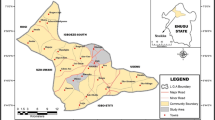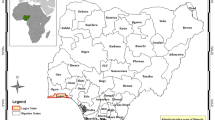Abstract
This paper presents the results from a study on the current state of tailing dump, surrounding soil and water in the region of Tarniţa-Suceava, Romania. A number of chemical analyses and germination tests were applied in an attempt to estimate the ability of soil to maintain the plants growing, the bioavailability, and heavy metals uptake. Total heavy metals, exchangeable metals, acidity, and carbon and nitrogen content were determined. A modified sequential extraction method was used to determine geochemical phase distribution of heavy metals. The most abundant heavy metals in the studied samples were Cu, Zn, and Pb. Elevated concentrations of As were also found. The results from sequential extraction revealed that up to 51% of copper was retained by amorphous and crystalline iron oxides in soil. Higher content of lead was noticed in amorphous iron oxide fraction. The heavy metal concentration in river water during dry season varied from 0.13 mg/L (Fe) to 4.2 mg/L (Zn) and was below the maximum contamination level for drinking water. The soil toxicity and heavy metal bioavailability of tailing dump material and surrounding soils were studied by germination tests. The germinated plantlets on the studied soils were found to accumulate elevated concentrations of heavy metals thus indicating the bioavailability of soil contaminants. Soil decontamination by distilled water or magnesium nitrate solution was found to be efficient enough to improve the capability of the studied soils to support the germination process.



Similar content being viewed by others
References
Arenas-Lago D, Andrade ML, Lago-Vila M, Rodríguez-Seijo A, Veg FA (2014) Sequential extraction of heavy metals in soils from a copper mine: distribution in geochemical fractions. Geoderma 230–231:108–118
Chicoș М, Damian G, Stumbea D, Buzgar N, Ungureanu T, Nica V, Iepure G (2016) Mineralogy and geochemistry of the tailings pond from Straja Valley (Suceava County, Romania). Factors affecting the mobility of the elements on the surface of the waste deposit, Carpathian. J Earth Environ Sci 11:265–280
Covelo EF, Vega FA, Andrade ML (2007) Competitive sorption and desorption of heavy metals by individual soil components. J Hazard Mater 140:308–315
Crane RA, Sapsford DJ (2018) Towards greener lixiviants in value recovery from mine wastes: efficacy of organic acids for the dissolution of copper and arsenic from legacy mine tailings. Minerals 8:383
Ding Z, Wang Q, Hu X (2013) Extraction of heavy metals from water-stable soil aggregates using EDTA. Procedia Environ Sci 18:679–685
Dong X, Li C, Li J, Wang J, Liu S, Ye B (2010) A novel approach for soil contamination assessment from heavy metal pollution: a linkage between discharge and adsorption. J Hazard Mater 175:1022–1030
Fedotov PS, Dzhenloda RK, Dampilova BV, Doroshkevich SG, Karandashev VK (2018) Unexpected behavior of Zn, Cd, Cu, and Pb in soils contaminated by ore processing after 70 years of burial. Environ Chem Lett 16:637–645
Georgiev P, Groudev S, Spasova I, Nicolova M (2014) Ecotoxicological characteristic of a soil polluted by radioactive elements and heavy metals before and after its bioremediation. J Geochem Explor 142:122–129
Georgieva S, Garsiyanova K, Ivanova V, Vladimirova L (2018) Assessment of physical-chemical characteristics of surface water from key sites of the mesta river: state and environmental implications. IOP Conf. Series. Mater Sci Eng 374:012093
Ghosh M, Singh SP (2005) A review on phytoremediation of heavy metals and utilization of it’s by products. As J Energy Env 6:214–231
Gitari MW, Akinyemi SA, Ramugondo L, Matidza M, Mhlongo SE (2018) Geochemical fractionation of metals and metalloids in tailings and appraisal of environmental pollution in the abandoned Musina Copper Mine, South Africa. Environ Geochem Health 40:2421–2439
Hendershot WH, Duquette M (1986) A simple barium chloride method for determining cation exchange capacity and exchangeable cations. Soil Sci Soc Am J 50:605–608
Hu XF, Jiang Y, Shu Y, Hu X, Liu L, Luo F (2014) Effects of mining wastewater discharges on heavy metal pollution and soil enzyme activity of the paddy fields. J Geochem Explor. https://doi.org/10.1016/j.gexplo.2014.08.001
Hwang SS, Park JS, Namkoong W (2007) Ultrasonic-assisted extraction to release heavy metals from contaminated soil. J Ind Eng Chem 13:650–656
Iacoban C, Risca IM, Roibu C, Ciornea ET, Necula R, Ilieva D, Sandu I, Drochioiu G (2019) Tarnita polluted area: accumulation of heavy metals and nutrients from the soil by woody species. Rev Chim Bucharest 70:753–758
ICRCL (1987) Guidance on the assessment and redevelopment of contaminated land, 2nd edn. ICRCL, Guidance Note 59/83, London
Ilieva D, Surleva A, Murariu M, Drochioiu G, Al Bakri Abdullah MM (2018) Evaluation of ICP-OES method for heavy metal and metalloids determination in sterile dump material. Solid State Phenom 273:159–166
Ilieva D, Angelova L, Drochioiu G, Murariu M, Surleva A (2019) Estimation of soil and tailing dump toxicity: development and validation of a protocol based on bioindicators and ICP-OES. ICIR 2019, IOP Conference Series: Materials Science and Engineering (in print)
Jez E, Lestan D (2015) Prediction of blood lead levels in children before and after remediation of soil samples in the upper Meza Valley, Slovenia. J Hazard Mater 296:138–146
Kossoff D, Hudson-Edwards KA, Dubbin WE, Alfredsson M (2012) Major and trace metal mobility during weathering of mine tailings: implications for floodplain soils. Appl Geochem 27:562–576
Li SW, Li J, Li HB, Naidu R, Ma LQ (2015) Arsenic bioaccessibility in contaminated soils: coupling in vitro assays with sequential and HNO3 extraction. J Hazard Mater 295:145–152
Mahar A, Wang P, Ali A, Awasthi MK, Lahori AH, Wang Q, Li R, Zhang Z (2016) Challenges and opportunities in the phytoremediation of heavy metals contaminated soils: a review. Ecotoxicol Environ Saf 126:111–121
Mao X, Jiang R, Xiao W, Yu J (2015) Use of surfactants for the remediation of contaminated soils: a review. J Hazard Mater 285:419–435
Mühlbachová G (2011) Soil microbial activities and heavy metal mobility in long-term contaminated soils after addition of EDTA and EDDS. Ecol Eng 37:1064–1071
Nieva NE, Borgnino L, García MG (2018) Long term metal release and acid generation in abandoned mine wastes containing metal-sulphides. Environ Pollut 242:264–276
Park B, Son Y (2017) Ultrasonic and mechanical soil washing processes for the removal of heavy metals from soils. Ultrason Sonochem 35:640–645
Pehoiu G, Radulescu C, Murarescu O, Dulama ID, Bucurica IA, Teodorescu S, Stirbescu RM (2019) Health risk assessment associated with abandoned copper and uranium mine tailings. Bull Environ Contam Toxicol 4:504–510
Ramírez-Pérez AM, Paradelo M, Nóvoa-Munoz JC, Arias-Estévez M, Fernández-Sanjurjo MJ, Álvarez-Rodríguez E et al (2013) Heavy metal retention in copper mine soil treated with mussel shells: batch and column experiments. J Hazard Mater 248–249:122–130
Sarma H (2011) Metal hyperaccumulation in plants: a review focusing on phytoremediation technology. J Environ Sci Technol 4:118–138
Secondary Drinking Water Standards: Guidance for Nuisance Chemicals Table of Secondary Drinking Water Standards. Available: https://www.epa.gov/dwstandardsregulations/secondary-drinking-water-standards-guidance-nuisance-chemicals. Accessed 25 May 2019
Slattery W, Conyers M, Aitken R (1999) Soil pH, aluminium, manganese and lime requirement. In: Peverill KI, Sparrow L, Reuter D (eds) Soil Analysis: An Interpretation Manual. CSIRO, Australia, pp 103–125
Solomon F (2009) Impacts of copper on aquatic ecosystems and human health, Environment & Communities, MINING.com January 2009, 25-28
Stumbea D (2013) Preliminaries on pollution risk factors related to mining and ore processing in the Cu-rich polymetallic belt of Eastern Carpathians, Romania. Environ Sci Pollut Res 20:7643–7655
Stumbea D (2017) Zinc in the flotation tailings pond of Brăteasa Valley (Suceava County, Romania), Anal. Stiint. Univer.“Al. I. Cuza” din Iasi. Ser Geol 63:37–49
Stumbea D (2019) Waste of the Straja valley tailings pond (Suceava county, Romania). Geochemical properties and environmental risks related to wind-driven removal, Carpathian. J. Earth Environ. Sci 14:529–539
Wang F, Wang H, Al-Tabbaa A (2014) Leachability and heavy metal speciation of 17-year old stabilized/solidified contaminated site. J Hazard Mater 278:144–151
Wang Y, Ma F, Zhang Q, Peng C, Wu B, Li F, Gu Q (2017) An evaluation of different soil washing solutions for remediating arsenic-contaminated soils. Chemosphere 173:368e372
Acknowledgments
The authors are very thankful to Dr. Manuela Murariu (Petru Poni Institute, Romanian Academy of Science) for her contribution to the germination tests.
Funding
Lyudmila Angelova acknowledged the financial support of the National Program for Support of Young Researchers 2018–2020 funded by the Bulgarian Ministry of Education and Science.
Author information
Authors and Affiliations
Corresponding author
Additional information
Responsible editor: Philippe Garrigues
Publisher’s note
Springer Nature remains neutral with regard to jurisdictional claims in published maps and institutional affiliations.
Rights and permissions
About this article
Cite this article
Ilieva, D.M., Argirova, M., Angelova, L.Y. et al. Application of chemical and biological tests for estimation of current state of a tailing dump and surrounding soil from the region of Tarniţa, Suceava, Romania. Environ Sci Pollut Res 27, 1386–1396 (2020). https://doi.org/10.1007/s11356-019-06919-9
Received:
Accepted:
Published:
Issue Date:
DOI: https://doi.org/10.1007/s11356-019-06919-9




